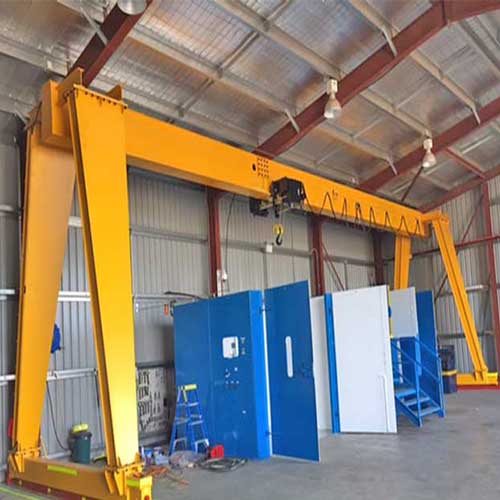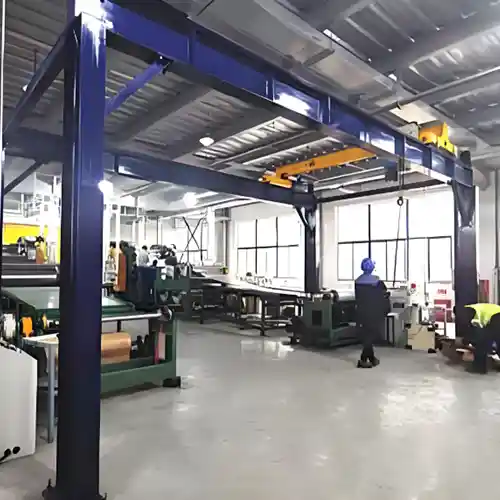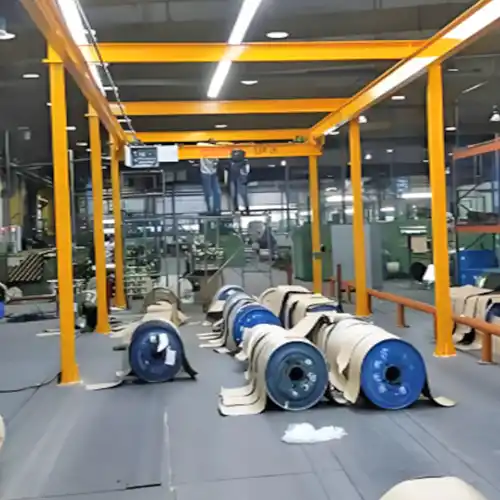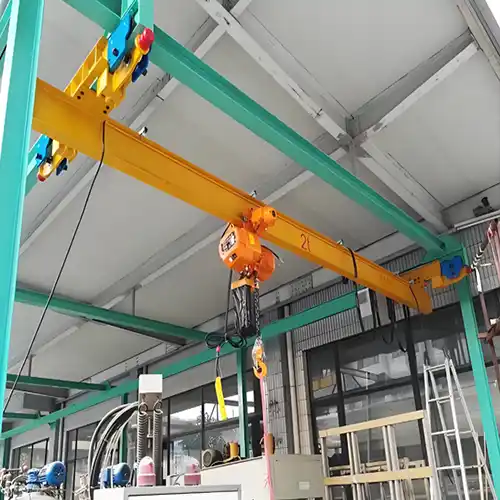Free Standing Gantry Crane, Free Standing Crane 3 Ton -100 Ton
Freestanding gantry crane 3 ton, 5 ton, 10 ton, 20 ton, 30 ton, 40 ton, 50 ton to 100 ton. Get your freestanding gantry system for your industrial sector.
| Crane type | Free standing gantry crane |
| Crane capacity | 1 ton - 320 ton |
| Lifting span | As your request |
| Lifting height | As customer requirement |
| Note | Customized free standing gantry cranes are available. |
Category: Freestanding Bridge Crane
Your Trusted Free Standing Crane Manufacturer & Supplier
Free Standing Gantry System 3 Ton, 5 Ton, 10 Ton to 100 Ton
Free Standing Gantry Crane for Sale, Economical from Gantry Crane Factory in China
Freestanding gantry crane overview -3 ton, 5 ton, 10 ton, 20 ton, 30 ton, 40 ton, 50 ton to 100 ton freestanding gantry system for your industrial sector.
Overview of freestanding gantry cranes
A freestanding gantry crane is a type of crane that is supported by upright columns or legs, allowing it to operate without requiring a permanent structure or building for support. It consists of a horizontal beam (the "gantry") that spans between two vertical legs or columns. This design gives the crane the ability to move objects horizontally along the length of the gantry and vertically using a hoist or trolley system.
Freestanding gantry cranes are commonly used in various industrial and commercial settings, including warehouses, workshops, construction sites, and manufacturing facilities. They are particularly useful in situations where a permanent overhead crane system is not feasible or when the workspace needs to remain flexible. These cranes offer advantages such as easy installation, mobility, and adaptability to different work areas.
The capacity of a freestanding gantry crane can vary widely, from lightweight models suitable for small tasks to heavy-duty versions capable of lifting substantial loads. They come in different configurations, such as single girder or double girder designs, depending on the weight and size of the loads they are intended to handle.
It's important to note that the specific features and capabilities of freestanding gantry cranes can vary based on manufacturers, designs, and intended applications.
Terminology Clarity:
The term "free standing gantry" or "free standing gantry crane" generally refers to a crane that is self-supporting, with gantry legs or columns. The specific configuration, such as single or double cell, may be mentioned to describe the crane's design or capacity.
In summary, a free standing gantry crane is a self-supporting crane with gantry legs or columns. The specific supporting structure configuration, such as single cell or double cell, can vary based on the crane's design and intended use. Stationary gantry cranes, on the other hand, rely on fixed structures for support and are not considered free standing.
The terminology and supporting structure configurations for free standing gantry cranes can vary, and it's essential to clarify the terminology for a better understanding:
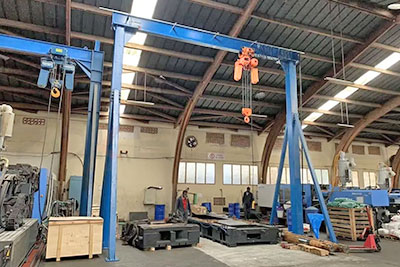
Stationary Gantry Crane (Fixed Gantry Crane):
- These cranes are typically permanently fixed to the ground or a foundation. They do not have wheels or mobility features. Stationary gantry cranes are not considered free standing because they are not self-supporting; they rely on a fixed structure.
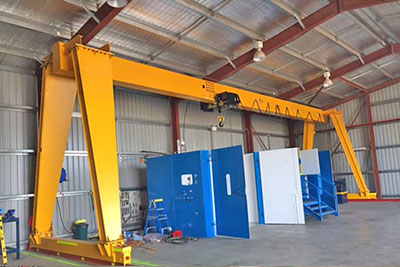
- Free standing gantry cranes are indeed self-supporting, meaning they do not require support from a building or structure. They are supported by gantry legs or columns that are part of the crane's design. These gantry legs or columns are typically positioned at each end of the crane and provide the necessary stability.
Supporting Structure Configurations:
- Free standing gantry cranes can come in various configurations, including single cell and double cell: 1)Single Cell: A single set of gantry legs or columns supports the crane. 2)Double Cell: Two sets of gantry legs or columns support the crane, providing additional stability and load capacity.
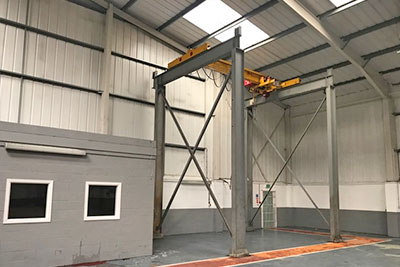
Single Cell freestanding Gantry Crane: In a single cell gantry crane, there is one set of gantry legs or columns that support the crane. These legs or columns are typically positioned at each end of the crane, forming a single cell of support. This configuration is common for smaller and lighter-duty gantry cranes.
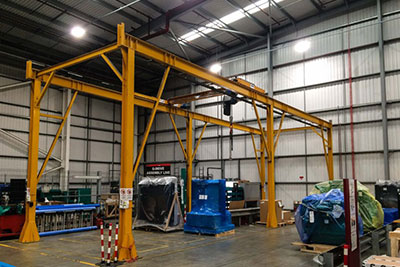
Double Cell Free Standing Gantry Crane: A double cell gantry crane has two sets of gantry legs or columns that support the crane. These legs or columns are positioned at each end and often in the middle, creating two cells of support along the length of the crane. This configuration provides increased stability and load capacity, making it suitable for heavier lifting tasks.
The term "cell" helps describe the arrangement of the supporting structures and their configuration within the gantry crane. It's a way to specify how the crane's legs or columns are positioned to provide stability and support for lifting operations.
The free standing gantry cranes with a single or double cell configuration can sometimes be referred to as "free standing bridge cranes." The term "bridge crane" is often used to describe a type of overhead crane that spans an area and is supported by two parallel runways. In the case of a free standing gantry crane with a single or double cell, the horizontal beam that spans between the gantry legs or columns can resemble the "bridge" of a traditional overhead crane.
However, it's essential to note that terminology can vary depending on region, industry, and specific applications. While "free standing bridge crane" is a descriptive term that can be used, the primary designation for such cranes is typically "free standing gantry crane." The use of terminology may also be influenced by the specific design and usage of the crane within a particular industry or facility.
Main types of free standing gantry cranes
Now let's look into the typical features, capacity, mounting types, mobility, benefits, typical applications, and industries commonly used for each type of free standing gantry crane:

Stationary Free Standing Gantry Crane:
- Typical Features: Fixed position, sturdy steel construction, stationary gantry legs.
- Capacity: Wide range, from light to heavy-duty, depending on specifications.
- Mounting Type: Permanently anchored to a concrete foundation or ground.
- Mobility: Stationary, does not move horizontally.
- Benefits: Stability, reliability, ideal for dedicated work areas.
- Typical Applications: Material handling, assembly, maintenance tasks in fixed locations.
- Industries Used: Manufacturing, workshops, warehouses, construction.
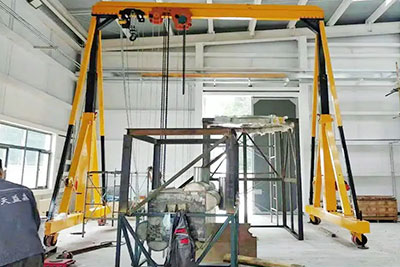
Mobile Free Standing Gantry Crane:
- Typical Features: Equipped with wheels or casters, adjustable gantry height may be available.
- Capacity: Moderate to high, depending on design and specifications.
- Mounting Type: Freestanding with mobility features.
- Mobility: Mobile within a defined workspace, easily repositioned.
- Benefits: Versatility, adaptability to changing tasks, no fixed rails required.
- Typical Applications: Versatile material handling, loading/unloading, manufacturing.
- Industries Used: Warehousing, logistics, workshops, construction, maintenance.
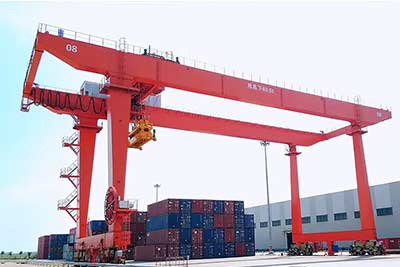
Rail-Mounted Free Standing Gantry Crane:
- Typical Features: Wheels or trolleys that travel along ground rails or tracks.
- Capacity: High lifting capacity, suitable for heavy loads.
- Mounting Type: Freestanding with rails or tracks for horizontal movement.
- Mobility: Horizontal movement along the rails, precise positioning.
- Benefits: Excellent load stability, precise positioning, suitable for long spans.
- Typical Applications: Loading/unloading from trucks, large material handling, industrial operations.
- Industries Used: Shipping ports, manufacturing, construction, heavy industry.

Adjustable Height Free Standing Gantry Crane:
- Typical Features: Gantry legs with telescopic or adjustable sections for varying height.
- Capacity: Variable, depending on design and specifications.
- Mounting Type: Typically stationary but with height-adjustment capability.
- Mobility: Limited to height adjustment, does not move horizontally.
- Benefits: Adaptability to varying ceiling heights, versatile.
- Typical Applications: Facilities with changing ceiling heights, versatile material handling.
- Industries Used: Warehousing, manufacturing, maintenance, production.
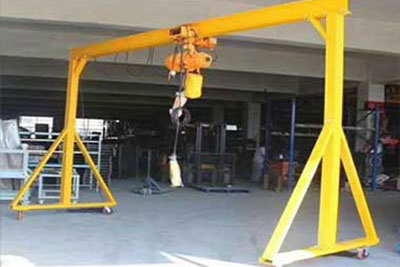
Portable Fixed Height Free Standing Gantry Crane:
- Typical Features: Designed for easy disassembly and transportation.
- Capacity: Moderate to high, depending on design and specifications.
- Mounting Type: Freestanding with portability features.
- Mobility: Highly mobile, can be set up quickly in various locations.
- Benefits: Portability, suitable for remote or temporary projects.
- Typical Applications: On-site construction, field maintenance, remote work areas.
- Industries Used: Construction, infrastructure development, remote operations.
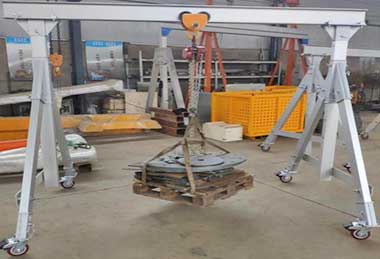
Aluminum Free Standing Gantry Crane:
- Typical Features: Lightweight aluminum construction.
- Capacity: Light to moderate loads.
- Mounting Type: Freestanding, often stationary.
- Mobility: Limited to manual movement or lightweight loads.
- Benefits: Portability, corrosion resistance.
- Typical Applications: Outdoor events, boatyards, light-duty material handling.
- Industries Used: Events and entertainment, marine, light manufacturing.
The choice of which type of free standing gantry crane to use depends on the specific requirements of the task and the industry. Each type offers unique advantages to meet a wide range of lifting and material handling needs.
Other types of free standing gantry cranes
- 1. Electric Chain Hoist Free Standing Gantry Crane: This crane is equipped with an electric chain hoist, making it ideal for precise material handling tasks. Typical applications include lifting and positioning loads in workshops, warehouses, and manufacturing facilities where controlled and accurate lifting is crucial.
- 2. Wire Rope Hoist Free Standing Gantry Crane: Designed with a wire rope hoist for heavy-duty lifting, this crane is suitable for applications like heavy machinery assembly, manufacturing processes, steel fabrication, and construction projects requiring robust lifting capabilities.
- 3. Pneumatic (Air) Hoist Free Standing Gantry Crane: Powered by compressed air, this crane is known for its clean and efficient operation. It's commonly used in environments where cleanliness and spark-free lifting are essential, such as hazardous locations, clean rooms, and chemical plants.
- 4. Manual Control Free Standing Gantry Crane: This crane is manually operated, typically using hand cranks or levers. It's suitable for simpler material handling tasks, maintenance operations, and workshops with lighter loads.
- 5. Semi-Automatic Control Free Standing Gantry Crane: Combining manual and automated controls, this crane offers improved efficiency and versatility. It finds applications in manufacturing, production lines, and warehouses requiring semi-automated load handling.
- 6. Fully Automatic Control Free Standing Gantry Crane: Operated entirely by automated systems with advanced control features, this crane is utilized in high-speed production lines, automated manufacturing processes, and integrated logistics systems.
- 7. Grab Bucket Free Standing Gantry Crane: Equipped with a grab bucket attachment, this crane excels at handling loose materials like bulk goods. It's commonly used in ports, mines, and material recycling facilities for loading and unloading bulk cargo.
- 8. Magnet Attachment Free Standing Gantry Crane: Featuring an electromagnet attachment for lifting ferrous materials, this crane is essential in scrap metal handling, steel mills, and metal recycling operations.
- 9. Spreader Beam Free Standing Gantry Crane: With a spreader beam for lifting and positioning large or irregularly shaped loads, this crane is invaluable in handling oversized or complex objects encountered in construction, shipyards, and heavy industry.
- 10. Explosion-Proof Free Standing Gantry Crane: Designed for safe operation in hazardous environments containing explosive gases or materials, this crane finds application in chemical plants, refineries, and the oil and gas industry in potentially dangerous areas.
- 11. Clean Room Free Standing Gantry Crane: Crafted with materials and designs that adhere to stringent cleanliness and contamination control standards, this crane is indispensable in pharmaceutical production, semiconductor manufacturing, and aerospace clean rooms.
- 12. Corrosion-Resistant Free Standing Gantry Crane: Constructed from materials resistant to corrosion, this crane is well-suited for chemical processing plants, saltwater environments, and marine applications where exposure to harsh chemicals or environmental conditions is common.
Optional or added features of free standing gantry cranes
Free standing gantry cranes can be equipped with various optional features or added features to enhance their functionality, safety, and efficiency. These optional features are often customizable based on the specific needs of the user or the industry. Here are some common optional features:
- 1. Remote Control: Remote control systems allow operators to control the crane from a distance, providing flexibility and improved visibility during operation.
- 2. Load Monitoring and Safety Systems: These systems include load sensors and overload protection devices that provide real-time feedback on the weight being lifted and help prevent overloading.
- 3. Variable Frequency Drives (VFDs): VFDs enable precise control of lifting and travel speeds, promoting smoother and more efficient operations.
- 4. Collision Avoidance Systems: These systems use sensors and alarms to prevent collisions between the crane and obstacles, enhancing safety in congested work environments.
- 5. Rotating Hooks or Trolley: Some gantry cranes feature hooks or trolleys that can rotate, allowing for easier load positioning.
- 6. Power Supply Options: Gantry cranes can be designed to run on various power sources, including electricity, diesel, or even batteries for greater flexibility in different environments.
- 7. Weatherproofing and Corrosion Resistance: For outdoor applications, weatherproof and corrosion-resistant coatings protect the crane from the elements and extend its lifespan.
- 8. Emergency Stop Systems: These systems allow for immediate shutdown in case of an emergency, enhancing safety during critical situations.
- 9. Telemetry and Monitoring: Remote monitoring systems provide real-time data on the crane's performance, maintenance needs, and operational efficiency.
- 10. Attachment and Tooling Options: Gantry cranes can be equipped with specialized attachments and tooling to handle specific types of loads or perform unique tasks.
- 11. Auxiliary Hoists: Additional hoists can be added to increase lifting capacity or accommodate multiple lifting points.
- 12. Load Spreaders and Spreader Bars: These accessories distribute the load weight evenly, reducing stress on the crane and the load being lifted.
- 13. Operator Cabin or Platform: An operator cabin or platform can be added for improved visibility and operator comfort during long shifts.
- 14. Automated Control Systems: Advanced control systems can be integrated for automation, allowing for pre-programmed movements and reducing the need for manual operation.
- 15. Telescoping or Extendable Features: Certain gantry cranes offer telescoping or extendable sections to adjust the height or span as needed.
- 16. Dust and Spark-Resistant Features: For use in environments where dust or sparks are present, specialized components can be incorporated to minimize the risk of ignition.
- 17. Emergency Backup Power: Backup power sources such as generators or UPS systems can be added to ensure crane operation during power outages.
- 18. Lighting and Cameras: Improved lighting and camera systems can enhance visibility for the operator, especially in low-light conditions.
- 19. Soundproofing and Noise Reduction: Features can be added to reduce noise levels during crane operation, improving the working environment.
These optional features are designed to meet specific industry requirements, improve safety, and optimize the performance of free standing gantry cranes for various applications. The choice of optional features depends on the intended use and operational needs of the crane.
Industrial applications of free standing gantry system
In the following the overview of free standing gantry crane system are provided for your reference, in which the main types of freestanding gantry cranes used in each of the mentioned industrial sectors, along with their tailored features, functions, and applications are provided for your refernce.
Manufacturing:
- Types: Single girder or double girder gantry cranes.
- Tailored Features: High precision, ease of control, adaptable to different production processes.
- Functions: Material movement, assembly, and positioning of components.
- Applications: Automotive assembly lines, electronics manufacturing, heavy machinery production.
Warehousing and Distribution:
- Types: Single girder gantry cranes with adjustable height features.
- Tailored Features: Versatile lifting heights, maneuverability in tight spaces.
- Functions: Loading and unloading of trucks and containers, storage area organization.
- Applications: Distribution centers, warehouses, logistics hubs.
Construction:
- Types: Portable gantry cranes.
- Tailored Features: Portability, quick setup, adaptability to changing construction sites.
- Functions: Lifting construction materials, assisting in erection of structures.
- Applications: Building construction, infrastructure projects.
Shipbuilding and Ports:
- Types: Heavy-duty double girder gantry cranes.
- Tailored Features: High lifting capacities, long spans, precise positioning.
- Functions: Moving ship components, loading and unloading cargo from ships.
- Applications: Shipyards, container terminals, port facilities.
Aerospace and Aviation:
- Types: Specialized double girder gantry cranes with precision controls.
- Tailored Features: Accurate positioning, safety systems for delicate aircraft parts.
- Functions: Handling aircraft components during manufacturing and maintenance.
- Applications: Aircraft production plants, maintenance hangars.
Automotive Industry:
- Types: Single or double girder gantry cranes with adjustable lifting speeds.
- Tailored Features: Speed control, heavy load capabilities.
- Functions: Lifting engines, car parts, and subassemblies during production.
- Applications: Automotive manufacturing facilities.
Mining and Extractive Industries:
- Types: Heavy-duty double girder gantry cranes.
- Tailored Features: Robust construction, high lifting capacities.
- Functions: Moving heavy materials, equipment, and machinery in mining operations.
- Applications: Mines, quarries, extraction sites.
Energy and Utilities:
- Types: Heavy-duty double girder gantry cranes with precise controls.
- Tailored Features: Precision positioning, reliability.
- Functions: Installing and maintaining heavy machinery in power plants.
- Applications: Power generation facilities, utility plants.
Foundries:
- Types: Specialized single or double girder gantry cranes with heat-resistant features.
- Tailored Features: Heat-resistant components, sturdy construction.
- Functions: Handling molten metal, moving heavy casting molds.
- Applications: Metal foundries, casting operations.
Chemical and Petrochemical:
- Types: Corrosion-resistant single or double girder gantry cranes.
- Tailored Features: Corrosion-resistant materials, explosion-proof features.
- Functions: Handling chemical containers, equipment, and drums.
- Applications: Chemical processing plants, refineries.
Paper and Pulp Industry:
- Types: Single girder gantry cranes with adjustable heights.
- Tailored Features: Adaptable lifting heights, precision controls.
- Functions: Moving heavy paper rolls, equipment, and materials.
- Applications: Paper mills, pulp processing facilities.
These tailored features, functions, and applications highlight how different industrial sectors utilize various types of freestanding gantry cranes to meet their specific needs. Each type is designed to address the unique challenges and requirements of the respective industries, ensuring efficient material handling, lifting, and positioning operations.
Life time care to your free standing gantry cranes
Designing, buying, installing, operating, and maintaining a free standing gantry crane involves several crucial considerations to ensure safety, efficiency, and longevity. Here are important points to note at each stage:
Design:
- 1. Load Requirements: Determine the maximum load capacity and size of the crane to match the application's needs.
- 2. Site Assessment: Evaluate the workspace, including floor conditions and ceiling height, to ensure the crane's suitability.
- 3. Safety Features: Incorporate safety features such as limit switches, emergency stop buttons, and overload protection.
- 4. Compliance: Ensure compliance with local regulations, codes, and industry standards.
- 5. Future Expansion: Consider potential future changes in load requirements and workspace to allow for crane adaptability.
Buying:
- 1. Supplier Selection: Choose a reputable supplier or manufacturer with a track record of quality and safety.
- 2. Specifications: Review and confirm all crane specifications, including capacity, dimensions, and features.
- 3. Warranty: Understand the warranty terms and service agreements provided by the supplier.
- 4. Budget: Establish a budget that includes not only the crane cost but also installation, maintenance, and operating expenses.
- 5. Training: Plan for operator training and ensure that personnel are qualified to operate the crane safely.
Installation:
- 1. Foundation: Ensure the foundation or ground is properly prepared and capable of supporting the crane's weight and loads.
- 2. Leveling: Precisely align the gantry legs and the horizontal beam to ensure stability and load distribution.
- 3. Bolting and Welding: Secure all connections, bolts, and welds according to manufacturer guidelines and engineering standards.
- 4. Alignment: Verify that the crane is aligned correctly and that all components are properly positioned.
- 5. Testing: Conduct thorough testing, including load tests and operational checks, before putting the crane into service.
- 6. Safety Measures: Install safety barriers, warning signs, and other safety measures as needed to protect personnel and equipment.
Operation:
- 1. Operator Training: Ensure that operators are trained and certified to operate the crane safely and efficiently.
- 2. Load Limits: Adhere to specified load limits and avoid overloading the crane.
- 3. Regular Inspections: Conduct routine visual inspections and maintenance checks before each use.
- 4. Safe Work Practices: Implement safe work practices, including clear communication, to prevent accidents.
- 5. Emergency Procedures: Train personnel in emergency procedures and ensure access to emergency stop controls.
- 6. Documentation: Maintain records of inspections, maintenance, and any incidents.
Future Maintenance:
- 1. Scheduled Inspections: Establish a regular inspection schedule based on usage and manufacturer recommendations.
- 2. Maintenance Records: Keep detailed records of maintenance activities and repairs.
- 3. Component Replacement: Replace worn or damaged components promptly to prevent further issues.
- 4. Lubrication: Ensure proper lubrication of moving parts to maintain smooth operation.
- 5. Upgrades: Consider upgrades or modifications to improve crane performance or safety as needed.
- 6. Training: Continue to provide ongoing training for operators and maintenance personnel.
Regular maintenance and adherence to safety procedures are essential to extend the lifespan of the gantry crane and minimize the risk of accidents. Always refer to the manufacturer's guidelines and follow best practices for safe operation and maintenance.
Related Products

Latest project
150 Ton Overhead Crane Installation Feedback – Paraguay Case
QDX 150 ton overhead crane in action in Paraguay. Installation photos, video, and client feedback show performance, safety, and heavy-lifting efficiency.
Free consultation to Confirm Parameters & Specifications and Get
Latest Crane Price & Crane Rate.
- Types of overhead cranes : _______?
- Optional: Overhead travelling crane, goliath gantry crane,Slewing jib crane, Single girder or double girder crane,small portable crane or kbk crane, etc.
- Capacity of overhead crane: _______?
- Optional: 0.25ton, 0.5 ton, 1 ton, 2 ton, 3ton, 5 ton, 10 ton,15ton, 20ton, 25 ton, 30ton,35ton, up to 550ton, etc.
- Crane span & lifting height : _______?
- Crane travelling length : _____?
- Control of overhead crane:_______?
- Optional: pendant/ remote/cabin control
- Voltage supply of overhead crane:_____?
- Eg,: 380V50/60HZ,3Phase or others,etc.
- Application/usage of crane:_______?
- Eg,: Steel mill, ,injection mold, cement,stone, concrete,granite, general manufacturing, etc.
Just leave a message via the contact form and our hoist and crane engineer will contact you with in 24working hours.
Get In Touch
